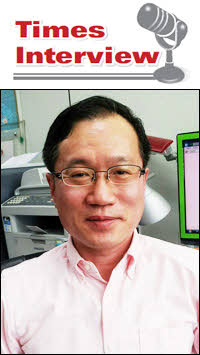Korean icebreaker leads world research

A veteran ocean researcher is taking the lead in the nation’s efforts to cope with the ever serious problems of climate change, under extreme conditions in polar regions.
Kang Sung-ho, director of the Climate Department at the Korea Polar Research Institute, recently returned home from the Arctic, sailing for 40 days with the nation’s first icebreaker Araon.
“The aim of the voyage was to investigate the structure and processes in water columns and subsurface in rapid transition,” he said.
Kang, who watches the changes of the earth’s environment on the actual ground, warned of the seriousness of climate change and explained it in an easy way, comparing it to candy.
“Assume that your mouth is the earth. When you eat candy, it takes a long time to finish it if you melt it in your mouth. But the time decreases if you bite it in two.”
“Glaciers melt in exactly the same way. The melting time is decreasing more and more because a lot of ice has been broken off because of global warming,” the 50-year-old scientist said during an interview with The Korea Times, Wednesday.
He said Korea’s status in science has increased thanks to the Araon. “When I started research on polar regions aboard an American icebreaker in 1987, I could never imagine that a Korean vessel could lead world research and carry scientists from all over the world. But it came true now.”
“These days, we contribute to forecasting environmental changes in the world and receive many calls to conduct joint research from various countries,” he said. “Many foreign researchers who conducted research on the Araon said its laboratories are high-tech and living facilities are state-of-the-art.”
“As a chief scientist of the mission, I was in charge of conducting all projects in a limited time, but safely. There were 53 researchers from 10 countries and a crew of 28 Koreans aboard the ship,” he added.
During his recent voyage, he engaged in video conference calls on Sep. 11 with President Lee Myung-bak and two other scientists from the Dasan Science Base in the Arctic and Sejong Base in Antarctica, while the President was visiting Norway.
“The President said that we need to keep the world informed that Korea is working hard in research of the polar regions with two bases and the Araon. He also stressed that investment in science should be made prior to resource development,” Kang said. “The President commended scientists’ hard work in extreme conditions as well.”
The chief scientist of the 7,487-ton icebreaker is now preparing a joint research project with the U.S. and Canada that will be conducted in Canada’s exclusive economic zone (EEZ) in August 2013.
“It is rare for a government to permit a foreign research ship to enter their territorial waters. But it was possible for us because we have the Araon, which is a moving high-tech laboratory,” he said.
The death of a young Korean scientist in the Antarctic region accelerated the birth of the Araon that is now leading world research in the polar oceans.
“We lost our scientist, Jeon Jae-kyu, from the Sejong Science Base in 2003 and his death raised a lot of voices on the need for researchers in the polar region to have the icebreaker. Following this there was a huge investment of 104 billion won (approximately $93 million) finally we could have our own icebreaker, the Araon in 2009.”
At the time, researchers used inflatable boats. The then 27-year-old Jeon was among eight people missing in a sudden blizzard in the Antarctic, and was found dead while the others were safely rescued.
Araon is returning home from Alaska. It will arrive at Incheon on Sep. 22, and then leave for the South Pole in the middle of October to help build a new base, the Jang Bo-go Station.
Kang was the first Korean scientist to go to the North Pole for research in 1999, but at the time he was on the Chinese icebreaker, Xuelong. His recent sailing with the Araon marked his 31st visit to the polar regions. <The Korea Times/Jun Ji-hye>




